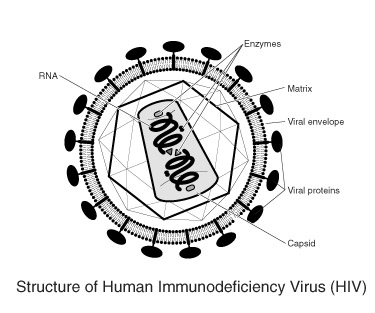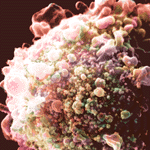|
HIV
is a retrovirus
 HIV
is an enveloped retrovirus.
Each virus
particle contains two copies of an RNA
genome. The virus also has a number
of enzymes:
reverse
transcriptase, integrase and viral
protease. These molecules play an important role in making
new copies of HIV and can be the targets of antiretroviral drugs.
The HIV viral particle, or virion,
has a capsid which
is cone-shaped and is enclosed in a lipid bilayer, or envelope.
This envelope contains viral glycoproteins which bind specifically
to CD4 T cell receptors, enabling the virus to enter its host. HIV
is an enveloped retrovirus.
Each virus
particle contains two copies of an RNA
genome. The virus also has a number
of enzymes:
reverse
transcriptase, integrase and viral
protease. These molecules play an important role in making
new copies of HIV and can be the targets of antiretroviral drugs.
The HIV viral particle, or virion,
has a capsid which
is cone-shaped and is enclosed in a lipid bilayer, or envelope.
This envelope contains viral glycoproteins which bind specifically
to CD4 T cell receptors, enabling the virus to enter its host.
The
name retrovirus comes from the fact that the RNA genome is transcribed/copied
back into DNA in the host cell (by reverse
transcriptase). The DNA is then incorporated into the host cell
chromosome.

HIV belongs
to a group of retroviruses called lentiviruses, from the Latin lentus,
meaning slow, because of the gradual course
of the disease they cause.
|





 HIV
is an enveloped
HIV
is an enveloped 